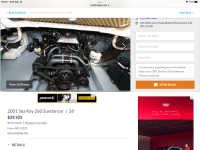Here is a buyer's checklist.
https://forums.iboats.com/threads/f...help-buying-a-boat-a-buyers-checklist.612841/
SAMS and NAMS are 2 marine surveyor accreditation organizations that have directories, so you can find a surveyor in your area. I also recommend Googling the names to see if there are good/bad reviews of them on boating forums. Plan on spending about $800 on a surveyor. Also you may want a separate engine inspection, as surveyors generally don't do that. Some have both vessel and engine certifications, or have someone they work with. FWIW - I spent $1500 on survey/sea trial/engine inspection for a 33 foot boat last year. Usually they charge 'by the foot', so you should be a bit less than that.
A sea trial (lake trial) with the surveyor/inspector aboard is probably the best way to test a boat. Putting an engine under its typical load is the way to see if there are any issues. Too many folks just rely on running the engine(s) on land (supplying water from a garden hose), only to find that the engine can barely get out of its own way once in the water.
Obvious signs of structural rot would be cracks in the fiberglass covering the stringers, loose engine mounting bolts, brown discoloration at structural joints, delamination, leaks around the transom plate of the outdrive.
Mercruiser upgraded the corrosion protection on the Bravo 3 outdrives on/about 2004, so the SeaRay probably has the older style anodes. There are retrofit kits to add the prop anode. If there is a bit of corrosion on the outdrive - beware - as it may have not been maintained properly. I've seen worse issues in fresh water than salt water, because many fresh water guys don't think they need to do any maintenance of the anode protection.




















